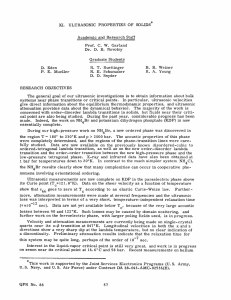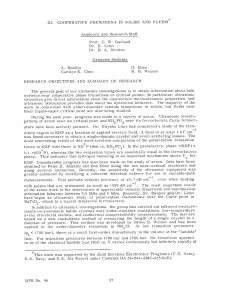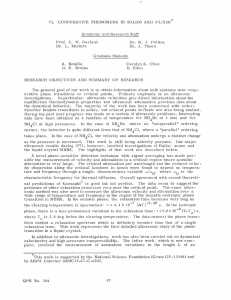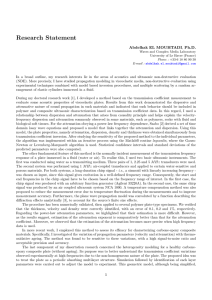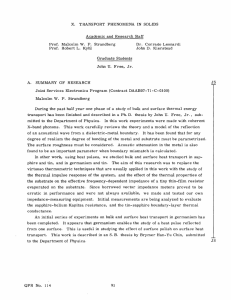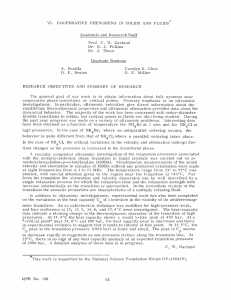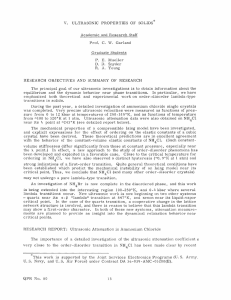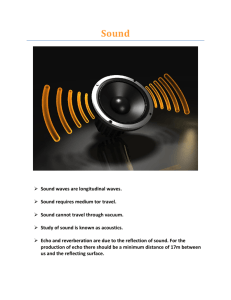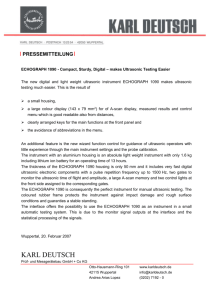XI. ULTRASONIC PROPERTIES OF SOLIDS
advertisement
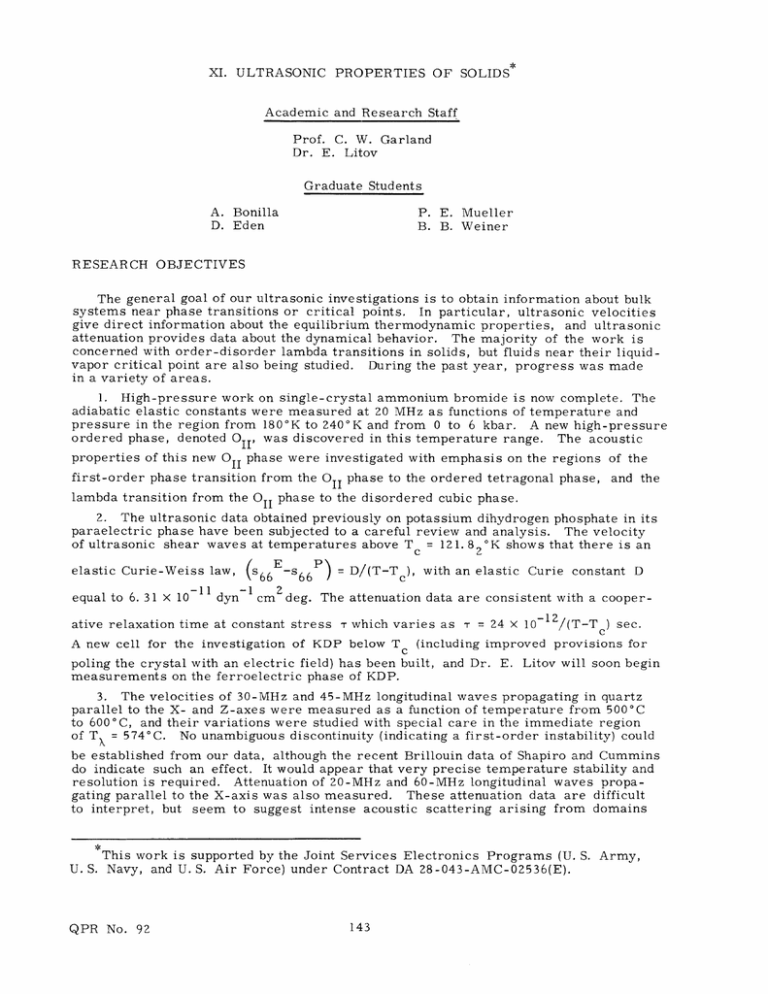
XI. ULTRASONIC PROPERTIES OF SOLIDS Academic and Research Staff Prof. C. W. Garland Dr. E. Litov Graduate Students A. Bonilla D. Eden P. E. Mueller B. B. Weiner RESEARCH OBJECTIVES The general goal of our ultrasonic investigations is to obtain information about bulk systems near phase transitions or critical points. In particular, ultrasonic velocities give direct information about the equilibrium thermodynamic properties, and ultrasonic attenuation provides data about the dynamical behavior. The majority of the work is concerned with order-disorder lambda transitions in solids, but fluids near their liquidvapor critical point are also being studied. During the past year, progress was made in a variety of areas. 1. High-pressure work on single-crystal ammonium bromide is now complete. The adiabatic elastic constants were measured at 20 MHz as functions of temperature and pressure in the region from 180 0 K to 240°K and from 0 to 6 kbar. A new high-pressure ordered phase, denoted OII, was discovered in this temperature range. The acoustic properties of this new OII phase were investigated with emphasis on the regions of the first-order phase transition from the OI phase to the ordered tetragonal phase, and the lambda transition from the Oii phase to the disordered cubic phase. 2. The ultrasonic data obtained previously on potassium dihydrogen phosphate in its paraelectric phase have been subjected to a careful review and analysis. The velocity of ultrasonic shear waves at temperatures above T = 121. 82K shows that there is an elastic Curie-Weiss law, (s 6 6 E-s 6 6 P) = D/(T-T ), with an elastic Curie constant D -11 -l 2 equal to 6. 31 X 1011 dyn cm deg. The attenuation data are consistent with a cooperative relaxation time at constant stress - which varies as T = 24 X 10 12 /(T-T c ) sec. A new cell for the investigation of KDP below Tc (including improved provisions for poling the crystal with an electric field) has been built, and Dr. E. measurements on the ferroelectric phase of KDP. Litov will soon begin 3. The velocities of 30-MHz and 45-MHz longitudinal waves propagating in quartz parallel to the X- and Z-axes were measured as a function of temperature from 500'C to 600 C, and their variations were studied with special care in the immediate region of TX = 574°C. No unambiguous discontinuity (indicating a first-order instability) could be established from our data, although the recent Brillouin data of Shapiro and Cummins do indicate such an effect. It would appear that very precise temperature stability and resolution is required. Attenuation of 20-MHz and 60-MHz longitudinal waves propagating parallel to the X-axis was also measured. These attenuation data are difficult to interpret, but seem to suggest intense acoustic scattering arising from domains This work is supported by the Joint Services Electronics Programs (U. S. Army, U. S. Navy, and U. S. Air Force) under Contract DA 28-043-AMC-02536(E). QPR No. 92 143 (XI. ULTRASONIC PROPERTIES OF SOLIDS) (microtwinning) over a range of approximately 20 near T. Outside this region there is a much lower attenuation that is roughly proportional to the frequency, conform to the expected critical variation in the relaxation time. 4. The attenuation of a longitudinal wave propagating in the and does not [100] direction of NII4Cl was measured as a function of temperature and pressure in the vicinity of the lambda line. At seven temperatures between 241. 0OK and 270. 2'K measurements at 10, 20, and 30 MHz were made as the pressure was varied from 1 bar to 3500 bar. One-atmosphere attenuation results were reinterpreted, by using recently obtained high-frequency velocity values from Brillouin scattering (~17 GHz) to calculate the relaxation strength. In the disordered phase, TSV behaves approximately as A/(T-T along the 1-atm isobar. In the ordered phase, )0 . 6 the TSV behavior at one atmosphere is more complicated and does not conform to simple theoretical models. Lines of constant attenuation in the ordered phase lie parallel to the lambda line; however, lines of constant attenuation in the disordered phase converge rather strongly toward the lambda line at high pressures. Thus, it appears that the dynamical properties follow a law of corresponding states in the ordered phase, but not in the disordered phase. 5. Much progress has been made in the past year on the liquid-vapor critical point in Xenon, although recurrent experimental problems have prevented the collection of ultrasonic data until recently. Preliminary data on Xenon indicate that the "singaround" method of velocity measurement will not work well without drastic modification. Therefore, the velocity measurements are being made by observing relative changes in the time delay of an arbitrarily selected cycle in the amplified RF signal from the receiving crystal as the transmitting crystal is moved by known amounts. The peak-topeak amplitudes measured at the same time and on the same cycle are used to calculate the attenuation. Uncertainties in the delay measurements are ~±0. 01 Fsec, and those in the relative spacing of the transducers are ~+0. 002 mm. Measurements at 16. 94 0 C (~0.35°C above the critical temperature) over a narrow range of pressure (58.6-57.7 atm) have yielded values of the velocity ranging from 99 msec-1 to 122 msec -1, and values of the attenuation ranging from 255 dB cm to 5 dB cm On the basis of these measurements, it is expected that data can be obtained in regions where the attenuation -1 is as large as 500 dB cm-1 6. By making direct measurements of the change in volume with pressure on a single crystal of NfI 4 C1 at several constant temperatures, it is anticipated that we can confirm the existence of a first-order transition which has been strongly suggested by elastic-constant measurement near the lambda line. Such a first-order instability associated with the NH 4C lambda transition has been predicted on the basis of a compressible Ising model, but a direct observation of the phenomenon and an investigation of the way in which 6V changes along the lambda line is important. A great deal of operating experience has been obtained with the gas compressor capable of generating pressures up to 3.4 kbar. The sample cell, which consists of a precision 3-lead, parallel-plate capacitor whose lower plate is supported by the crystal, has been constructed, assembled, and tested. The capacitance is measured by an impedance bridge that is driven at 1 kHz and a phase-sensitive "lock-in" amplifier. Thus, all components seem to be operative and data should be forthcoming soon. C. W. QPR No. 92 144 Garland (XI. ULTRASONIC PROPERTIES OF SOLIDS) Publications C. W. Garland and R. A. Young, "Order-Disorder Phenomena VI: Anomalous Changes in the Volume of Ammonium Chloride," J. Chem. Phys. 48, 146 (1968). C. W. Garland, Book Review of "Ultrasonic Absorption," by A. B. Bhatia, in Phys. Today 21, 101 (1968). C. W. Garland and R. A. Young, "Elastic Constants of Ammonium Bromide II. Highpressure Ultrasonic Investigation of the Phase Transition," J. Chem. Phys. (scheduled for December 15, 1968 issue). C. W. Garland and D. B. Novotny, "Ultrasonic Velocity and Attenuation in KH2P0O4 ," Phys. Rev. (scheduled for January 10, 1969 issue). QPR No. 92 145 a
